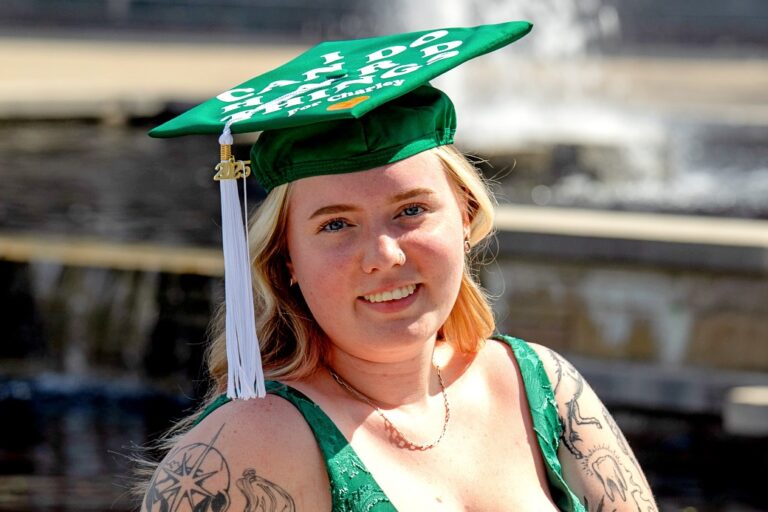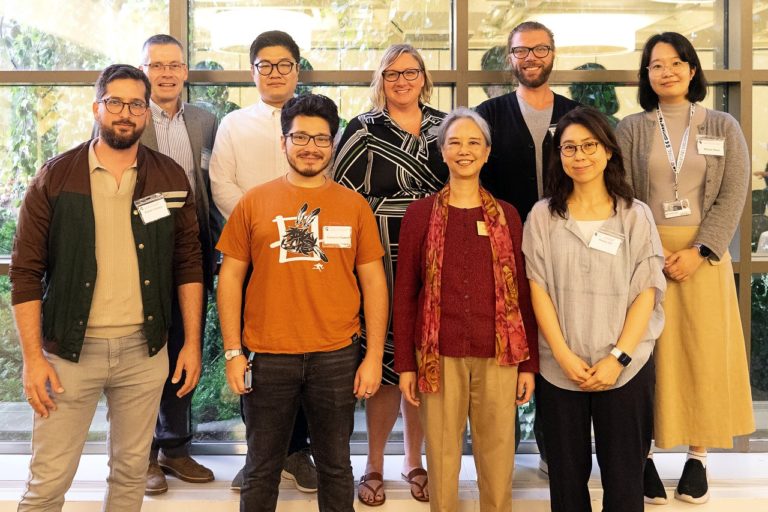As an Experience Designer for Ford Motor Co., Michigan State University graduate Calandra Berry is helping create the next generation of vehicles and is part of a core team of experience designers and engineers who are charged with making the fully electric Lincoln Star Concept Car a reality.
“We try to figure out how we’ll implement the features into the vehicle, as well as any limitations that we may have, and work with the features teams to make sure we’re making decisions that will please both our engineering department and, ultimately, the customer,” said Berry, who graduated from MSU with a B.A. in Experience Architecture (XA) in 2017.

By 2025, Lincoln aims to release three new fully electric vehicles, including the Lincoln Star, with plans to go fully electric by 2030. The Lincoln Star Concept Car is the brand’s electric vehicle prototype.
Berry has worked for Ford Motor Co. for five years, more than three in her current position as a member of the Experience Design and Engineering Team for the Lincoln Star Concept Car. The work she is doing coincides with her personal and professional priorities to create user experiences that make a real difference in people’s lives.
“We really want to hone in on customer needs…We want to create a driving experience that makes more of an impact.”
“We really want to hone in on customer needs,” Berry said. “We want to be able to relax the customer because we know that people are on the move, and the hustle and bustle of life can be draining. So, we want to create a driving experience that makes more of an impact.”

The Lincoln Star Concept emphasizes mindfulness — awareness in the present moment — the benefits of which include stress relief, relaxation, and mental clarity, making it especially useful for the millions of Americans who spend a good portion of their day in their cars. The concept will eventually be integrated into other Lincoln models, but no word yet on when.
“No official launch until you see a commercial,” said Berry, noting that new concepts typically take a minimum of three to four years to become fully realized.

The Lincoln Star showcases in-vehicle technology to enhance the moods of, and promote calm and well-being in, drivers and passengers. According to Ford, even before getting into the vehicle, drivers will be able to make the cabin environment “hygienic and harmonious” by pressing “unlock purge,” activated by a key fob or app, to provide a burst of clean air.
Other features include a premium filter that reduces allergens, bacteria, odors, and dust. Ultraviolet-c light diodes eliminate viruses and germs on phones, screens, and surfaces. Ambient light creates specific moods from calm to energetic, along with the B&O Besonic™ equalizer and headrest speakers, which deliver immersive, personalized sound. Driver’s seat actuators provide feedback on physiological markers such as breathing and heart rate, and wearables can synchronize that information with the light, sound, and climate controls. The concept car even includes mindfulness meditation guides and a power nap function with lay-flat seats for breaks during long drives.

The overall goal of these features is to make the roads safer by encouraging less distracted driving and empathy for other drivers while making the experience more pleasurable, said Berry.
Berry started her career at Ford in 2017 as a Human-Machine Interface (HMI) Designer working on building storyboards and wireframes for driver-screen interaction. She joined the Lincoln Star Concept Car team in 2019 and credits MSU’s interdisciplinary XA program with helping her to develop a flexible skill set and preparing her to tackle a wide array of challenges in the field.
“There’s a lot you can do in the world of user experience design with the classes I took in XA.”
“There’s a lot you can do in the world of user experience design with the classes I took in XA,” Berry said. “I took a project management class, a content strategy class, user research, web development, and quite a few others.”
Berry credits Professor Liza Potts, Co-Founder of the Experience Architecture program at MSU, as well as the MSU chapter of Design for America (DFA), with having a big impact on her academic direction and showing her that “what the field has to offer is only limited by my imagination.”

For Berry, the DFA was “an extracurricular that wasn’t necessarily about just having fun or just enjoying yourself but having fun while helping people and learning from each other. Each group had a project working with people from different majors. So, I was able to connect with people who were in math and science. We were all able to come together and come up with a solution for different problems.”
When Berry first came to Michigan State University, she didn’t know what she wanted to major in; she just knew she loved programming. Once she joined DFA, she learned from other students about the Experience Architecture major, which catalyzed her interest in experience design and targeted her professional passion for solving design problems that help people better use and enjoy the products they rely on.
“As an experience designer, having different experiences yourself can help you shape things for others. Being well-rounded is the ideal, and the XA program was great for that because it’s interdisciplinary.”
After graduating from MSU, Berry went on to earn her master’s degree in Human-Centered Design and Engineering from the University of Michigan-Dearborn.
Her advice to students who are considering entering the XA field stems from two experiences: interning at Honeywell in Seattle, where she lived and worked on her own for the first time just after her senior year at MSU, and, interestingly, from an elective course she took in Indigenous Studies, which opened her eyes to different cultures.

“As an experience designer, having different experiences yourself can help you shape things for others,” she said. “Being well-rounded is the ideal, and the XA program was great for that because it’s interdisciplinary. Everything isn’t one note. You won’t be focused on just one thing. There are always cool opportunities to have different experiences.”
MSU recently joined the Michigan Economic Development Corporation’s new Talent Action Team, a public-private partnership, to recruit electric vehicle and mobility talent to Michigan. To learn more, see the “MSU joins statewide effort to promote new careers in electric vehicles, mobility” article in MSU Today.
Written by Kim Popiolek
C


